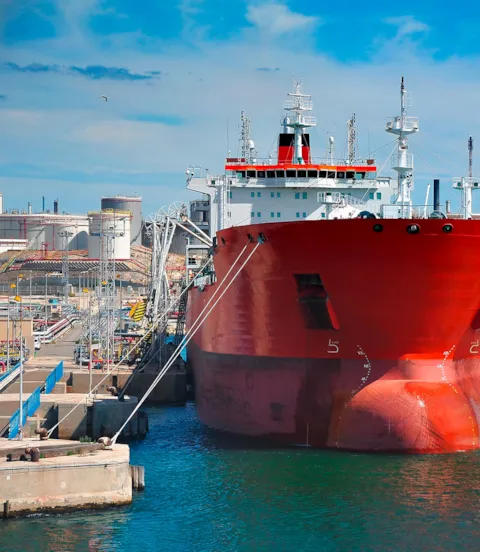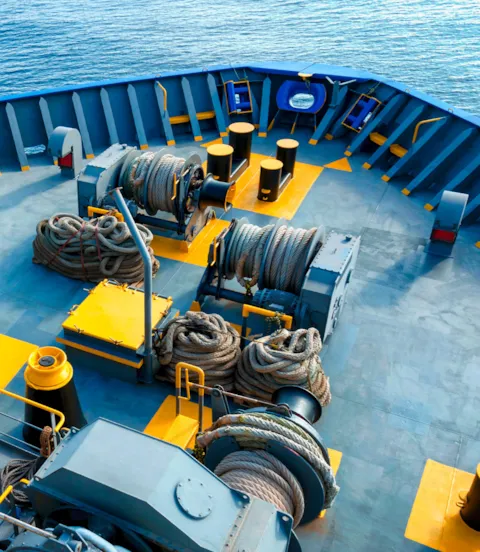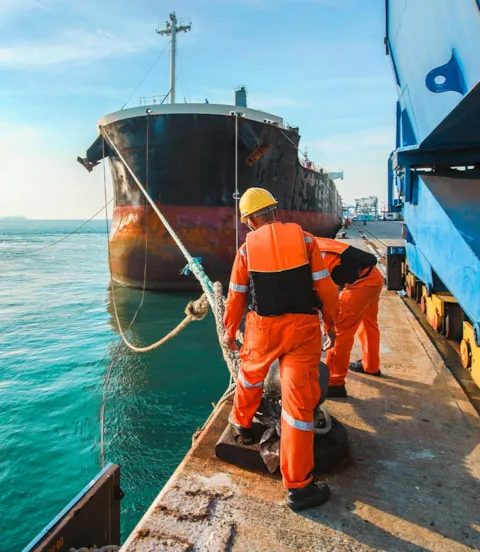A new look at safe mooring
Mooring is among the most common of all maritime tasks, yet mooring operations are far from standardized. In order to ensure safe mooring involving both new and existing tonnage and equipment, standards are currently being upgraded and conventional wisdom is being revisited.
The need for updated mooring standards and practices is being driven by key changes in the shipping industry. Among the variables being introduced into the mooring equation are larger ships, new materials and new mechanical systems.
“These developments are influencing the risk picture, and there has been a time gap in the update of routines,” says Yiyang Li, Ship Life Cycle Management Consultant, DNV GL, and lead consultant for DNV GL’s Safe Mooring Team. The result, he says, is that mooring safety has depended largely on seamanship and operator experience.

Numbers driving mooring safety response
Mooring incident is among the top seven types of insurance claims, reported by UK P&I club. Statistics from the European Harbour Master’s Committee indicate that in all mooring injuries registered, 95 percent are caused by ropes and wires, and 60 percent of these injuries happen during mooring operations. Over 220 mooring-related incidents were reported to the Australian Maritime Safety Authority between 2010 and 2014, with 22 percent of these resulting in injury.
In an effort to bring these numbers down, central mooring rules and regulations are being amended and updated. Amendments to SOLAS regulation II-1/3-8 and new guidelines for safe mooring for all ships were approved in 2019. The amended requirements and new guidelines are expected to enter into force on 1 January 2024.
By this date, all new ships will be required to comply with the revised regulations for appropriate and safe-to-use designs of mooring arrangements. All existing ships must comply with new regulations for in-service inspection and maintenance regimes for mooring equipment and lines, and provide proper documentation.

Mooring System Management Plan for tankers
Issued in 2018, the fourth edition of the Mooring Equipment Guidelines (MEG4) introduced the Mooring System Management Plan (MSMP) for tankers. Human-centric design principles are highlighted, along with a systematic approach to design and verification of mooring equipment, and a holistic application to managing mooring lines. MSMP, including Ship Design Minimum Breaking Load (MBL), has been adopted to the Ship Inspection Report (SIRE) vetting regime in the revised Vessel Inspection Questionnaire (VIQ7).
DNV GL’s help desks report receiving three to four new requests related to mooring every week for the past two years. In the tanker segment, seven percent of vetting inspection questions have been related to mooring since SIRE VIQ7 took effect in September of 2018.

Increasing number of lay-ups demand safe mooring processes
The COVID-19 pandemic has put restrictions on fleet in operations not previously experienced. Ports are denying entry to certain vessels, travel restrictions are in place, ships have been taken out of service, and crew have been laid off. These operational challenges are forcing some owners and operators to consider placing vessels in lay-up. A safe and robust lay-up mooring can usually support the owner’s decision for a lay-up, remove the biggest concerns from the local authorities, and even reduce the risk premium for the insurance and thus save costs. DNV GL’s recommended practice RP-0290 provides guidance on safe mooring during lay-up.

New mooring technologies require new guidelines
While promising advances in efficiency and performance, new mooring technologies must also be as safe or safer than existing solutions. For example, modern mooring lines are stronger, lighter and more elastic, but new materials present snapback challenges. “Snapback is critical because human life and safety are at risk when it occurs,” says Yiyang. He notes that snapback incidents involving big gas carriers have been studied extensively, leading the industry to take a more inclusive view of causes and prevention. “For the first time, we are looking at all the relevant factors together in order to resolve safety issues.”
A new generation of “smart ropes” equipped with sensors to communicate physical status is also emerging. “A smart rope is still a rope that needs maintenance and inspection,” Yiyang says. “Embedded sensors are one way of using digital tools to monitor operations and provide operators with additional data that they can use. But even if you know your limits, you still have to know how to manage them.” This will require new regimes for the maintenance and management of high-tech ropes, he says, based on knowledge gained in testing and trials.
Not restricted to equipment, digital technology is also impacting mooring practices. As with many ship operations, data on mooring exists, but it is not systematically collected. “Now we have platforms like Veracity for gathering and analysing data,” Yiyang reports. “We also need to know which non-sensitive data operators want to share and find a way to use it that is mutually beneficial to stakeholders and the industry.”

The human element in vessel mooring
With the aim of uncovering gaps between claimed and actual crew performance, DNV GL is conducting expert interviews and workshops involving the various roles in mooring operations. “We are also working to influence design using knowledge of human behaviour,” Yiyang says. Human-centric design principles have been introduced in recent bellwether guidelines such as MEG4, Section 2, offering a holistic approach to mooring equipment in general, and routines for the managing of mooring lines to ensure safer operations.
“The trend is moving towards ‘safe-to-use’ design. Humans have been considered in the design of equipment and facilities, but the focus has not been human-centric. Now we are performing critical task analysis with owners and operators, and we aim to share this approach with the design industry,” says Yiyang. “The goal is to allow human factors to have more influence in the design process. Not enough attention has been paid to overall solutions. The goal now is to consider the entire process from a combined human, operational and technological perspective.”

Mooring compliance in a changing world
As container and cruise ships become increasingly bigger and quicker, crews are being required to adjust their routines. For example, the practice of using spring lines to move ships is being called into question as ship size increases. In addition, the green shift in shipping is demanding more use of shore power, mandating stricter mooring parameters and heightened safety measures.

Combination carrier receives support in preparing an MSMP
Norwegian shipowner Klaveness recently introduced a new vessel design to make the process of switching between dry and wet bulk cargoes more efficient. In order to obtain new charters, the ships will need to meet mooring requirements in both segments.
DNV GL’s Safe Mooring Team has supported Klaveness in preparing a Mooring System Management Plan (MSMP) for the new combination carriers. Calculations were run to verify the effectiveness of system design, and workshops and interviews were held to review Klaveness’ mooring operational procedures, resulting in a list of proposed improvements.
The project was well received by the Klaveness team. Jarle Helleberg Kverneggen, head of HSEQ at Klaveness Ship Management, says: “With the support of DNV GL’s project team, we have successfully implemented MSMP for our first CLEANBU vessel. We feel that these measures have improved the management of our mooring system.”

Are ports prepared for new mooring realities?
“We have established a dialogue with several ports and terminals in order to uncover gaps in mooring practices and determine how best to fill them,” says Yiyang. “We are working with terminals to see what kind of data can help them to improve their decision-making.”
Site-specific analysis is a key measure towards this goal, he says. “ Some ports may have special requirement need to be followed by ships mooring at their facilities, and we can help ships and operators to develop a set of site-specific parameters.” Conversely, some ships will call at many diverse ports, and cruise ships are calling more often at exotic destinations, requiring reassurance of safety at ports with limited facilities. “Such site-specific analysis from a third-party can also facilitate the dialogue between ports and shipmasters and support their decision-making,” Yiyang says. “There is no doubt that effective mooring planning and operation can save considerable time and money, and potentially reduce harbour emissions by streamlining operations.”
Automatic mooring terminals are another way to reduce mooring time and minimize actions. “We are glad to see that some ports have implemented auto-mooring equipment,” says Yiyang. “This has the potential to enhance mooring safety since it significantly reduces human involvement, although such technology cannot completely eliminate the need for shipboard mooring equipment in the short term.”

Safe Mooring Connect facilitates safe operations
DNV GL is currently in dialogue with multiple clients, providing support for vessel risk assessment, reviewing mooring practices from the human factor perspective, offering customized support according to vetting observations or comments, and preparing MSMP plans according to MEG4. This should include the purchasing, maintenance and retirement of equipment as well as the qualification and training of mooring personnel.
To support customers in complying with upcoming regulations in a smart way, DNV GL has also launched a new hub on Veracity called Safe Mooring Connect. The hub facilitates safe mooring operations across three modules:
Module 1 – Ship Design MBL calculator for ship design philosophy and MSMP generation
Module 2 – Site-specific calculator and lay-up calculator for special mooring patterns as well as ship–port compatibility
Module 3 – Mooring line management for daily operation
“Safe Mooring Connect enables users to benefit from a convenient hub for mooring-system-related needs. The mooring calculator provides ship design MBL , and MEG4 compliance status and mooring analysis reports are now available online. New features, such as calculators for lay-up and other types of site-specific moorings, are planned in the next phases. A daily tool for mooring line management which will allow real-time self-checks and the sharing of mooring system information with relevant stakeholders and mooring line management solutions is under development,” Yiyang Li explains in an outlook.

What will new mooring recommendations mean for operators?
In order to ensure compliance with upcoming regulations, operators for all ship types are advised to review their mooring system design philosophies, assess and document risks, plan and implement appropriate risk mitigation measures, and more importantly, ensure heightened organizational awareness of system design limits. DNV GL also encourages the operators to re-evaluate their current procedures and practices, operations and maintenance for mooring equipment and mooring line management. This should include purchasing, maintenance and retirement, as well as mooring personnel qualification and training.
For tankers and gas carriers specially, Ship operators should generate the ship specific MSMP as per OCIMF recommendations, including all available information and records. It is recommended to perform a design review and document the MEG4 compliance level, assess and document the risks identified and take possible interim measures to manage the risks.
“Seeing the challenge for proper management of mooring lines, a joint industry effort from ropemakers, material providers, testing institutes and certification bodies is needed to implement new mooring line management standards, especially regarding retirement criteria,” Yiyang maintains. Qualification and training in mooring operations for both on-board crew and port personnel will also require joint industry effort, he adds.
For newbuilding projects, DNV GL recommends that mooring equipment and line selection follow the holistic approach prescribed in the latest guidelines, in order to ensure “safe-to-use” design. Yiyang notes that newbuild designs should identify and accommodate relevant mooring patterns and ensure that design criteria for mooring components are well defined. For new designs with large windage areas, such as cruise and container ships, he advises performing direct calculations as needed. For ship types that are typically moored for longer periods of time, such as FPSO and FSRU, Yiyang recommends that design standards above the minimum recommended criteria be considered.
For existing ships, operators are advised to conduct reviews of mooring practice on board to assess the effectiveness of the operation and identify areas for improvement. Yiyang adds that operators should keep abreast of new technologies that will require renewed or additional qualifications and see to it that crews are kept up to date with the necessary training.
“New recommendations imply stricter planning and follow-up of mooring operations and equipment,” sums up Carl Erik Høy-Petersen, Head of Section, Ship Life Cycle Management, DNV GL – Maritime. “Shipowners and operators will need to review their mooring procedures with respect to the updated guidelines. For many this will require rethinking established mooring procedures, and reconsidering existing mooring design.”

Yiyang Li
Senior Consultant | Safe Mooring Team Lead at DNV Maritime Advisory
- andrey polivanov - Shutterstock.com
- Druid007 – Shutterstock.com
- Avigator Fortuner – Shutterstock.com
- Iam_Anupong – Shutterstock.com